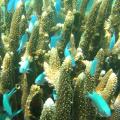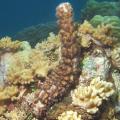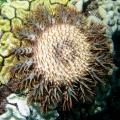Life Underwater
Egypt
|
The Red Sea was recently called one of the Seven Wonders of the Underwater World by a group of experts, but the many underwater highlights of Egypt have long been a magnet for divers and snorkelers. |

|
|
This isolation, and unusual conditions caused by it such as high salinity, has led to a high concentration of species which are found only here and in the neighbouring Gulf of Aden, such as this masked or blue-cheek butterflyfish, one of many endemic butterfly species. |

|
Fiji
Indonesia

|
If Indonesia is the heart of biodiversity, then the small area known as Lembeh Strait is the world epicenter of weirdness, with numerous bizarre creatures like this striped frogfish. |
|
Lembeh Strait is also home to a wide variety of invertebrate life, like this Mexichromis multituberculata sea slug caught in the process of laying eggs. |

|
The Philippine Islands

|
I was attracted to the Philippines by the prospect of being able to snorkel with whale sharks at the town of Donsol, twelve hours drive east of Manila. It's one of only two places in the world where you're guaranteed to see these creatures, the largest fish in all the ocean, the other being Ningaloo Reef in western Australia. |
|
I made this trip in 2006 with a new camera, and after only two days I decided to learn to scuba dive, rather than free diving with a weight belt as I'd done for the last ten or so years. My new ability to go deeper than I was previously able certainly paid dividends, with many sightings of things I hadn't seen before, like a cuttlefish, frogfishes and a sleeping parrotfish. These were some of the highlights of the trip, along with old friends like this moray eel. |

|

|
The new camera provided me for the first time with the ability to do underwater macro photography, allowing me to fill the photo with very small critters. Like many other underwater photographers before me, I set about finding nudibranchs, beautifully patterned and colored sea slugs which put their terrestrial counterparts to shame. |
Thailand
|
There are scary critters here too, like this banded sea snake, stingrays, lionfishes and scorpionfishes; however almost all of them are entirely unaggressive towards people, except for the occasional titan triggerfish which will vigorously defend its nest when breeding. So, properly understood, even these scary critters are part of the highlights of Thailand underwater. |

|






